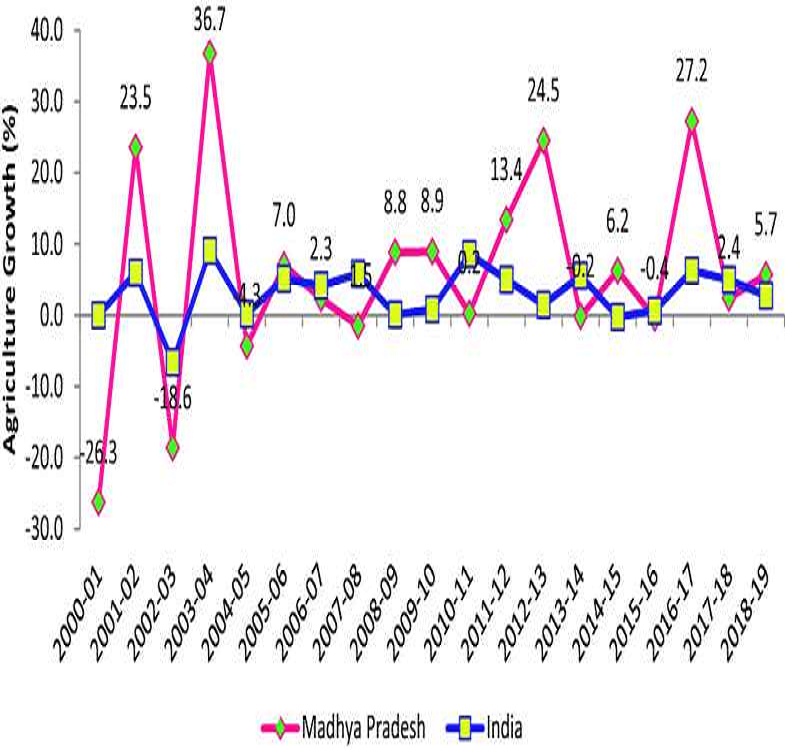Overview of Agriculture
Overview of Agriculture Sector in India: -
Agriculture is one of the strongholds of the Indian economy and accounts for 19.9 per cent of the country’s gross domestic product in 2020-21. Agriculture remains a dominant sector in terms of employment and livelihood. For more than half of India’s workforce, agriculture is the principal occupation. It still contributes significantly to export earnings and is an important source of raw materials as well as of demand for many industries..
India ranks second in the world in the production of farm output. Crop yield per unit area of all crops has grown since 1950 due to the special emphasis placed on agriculture in the five-year plans. Steady improvement in irrigation methods, adoption of technology, application of modern agricultural practices and provision of agricultural credit & subsidies have also contributed to increase in productivity.States such as Uttar Pradesh, Punjab, Haryana, Madhya Pradesh, Andhra Pradesh, Bihar, West Bengal, Gujarat and Maharashtra are the major producers of agricultural output in the country.
India is the world’s largest producer of milk, jute and pulses, and has the world's second largest cattle population. It is the world’s second largest producer of rice, wheat, sugarcane, cotton and groundnuts. India is also the second largest producer of fruits and vegetables, accounting for 10.9% and 8.6% of the world fruit and vegetable production respectively

India is not only one of the world’s largest producers of agricultural products, but also one of the largest consumers of food products. The India processed food market is projected to expand to US$ 470 Billion by 2025 from US$ 263 Billion in 2019-2020. Food processing is the fifth largest sector of the country's economy and contributes 13 per cent to our annual GDP. The growing consumption of food is expected to reach $ 1.2 Trillion by 2025-26, owing to these factors.
In an era of economic liberalization where the private (including co-operatives) and public sector play their rightful role in the development of the food processing sector, the government acts as a catalyst for bringing in greater investment. This sector witnessed healthy FDI inflow of US$ 18.19 Billion from April 2020 to March 2021. The food processing sector in India is a highly fragmented industry, comprising of sub-segments like fruits and vegetables.

Status of Agriculture in Madhya Pradesh (M.P)
The State is primarily an agriculture State. About 73% population of the state is rural, which is directly or indirectly depends on agriculture. Thus Agriculture Sector is the main Stay of the State economy. The Agriculture and allied services contributes about 44% share in state economy and 78% of its working force is directly engaged in Agriculture. Thus Agriculture sector forms the backbone of MP economy.
The state has been lauded for its excellent agricultural performance—MP’s agricultural GDP increased at 7.5% per annum during 2005–06 to 2018–19. The last three years have been even more remarkable: agricultural GDP grew at 11.5% per annum as compared to the national average of 4.7%.
The most important crops grown in Madhya Pradesh are rice, wheat, corn
(maize), sorghum (jowar), pulses (legumes such as peas, beans, or lentils), and
peanuts (groundnuts)The main factors that have contributed to agricultural growth in Madhya Pradesh
are: -
(i) Expanded irrigation through tube wells and canals.
(ii) Increased power supplies to agriculture.
(iii) Expansion of all-weather roads and.
(iv) Suitable incentives and signals for the private sector to increase the level of
investments to reap the benefits of trunk infrastructure and improved services.
© 2022 Himalayan Foods All Rights Reserved | Designed & Developed By India Websoft

payment success

Your order has been successfully processed! Please direct any questions you have to the store owner. Thanks for shopping
continue browsing



